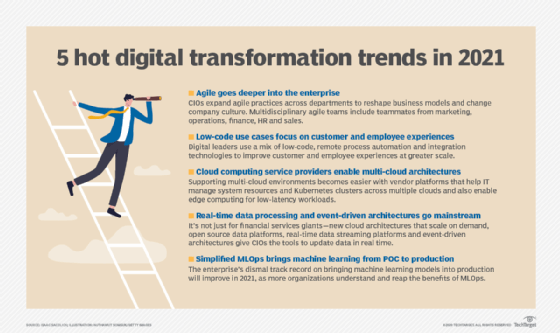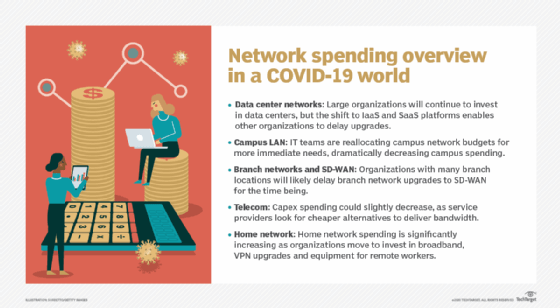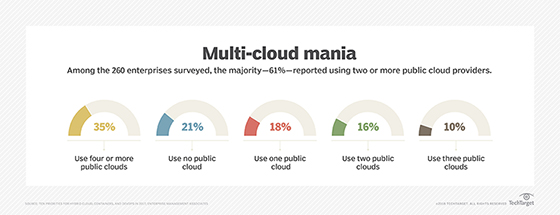Storage
- Editor's letterThese 5 IT buzzwords for 2021 reflect data storage priorities
- Cover storyThe best enterprise storage systems and products of 2020
- InfographicEfficient data storage tips to achieve a green data center
- FeatureEnterprise technology trends for 2021 shaped by COVID-19
- ColumnPay-per-use pricing model can boost digital initiatives
- ColumnCost-effective snapshot management tips and strategies

stock.adobe.com
Enterprise technology trends for 2021 shaped by COVID-19
Explore IT infrastructure and storage-related software, hardware and services that will likely be embraced in the coming year, and how the pandemic has influenced their use.
We approached experts, analysts and industry insiders and asked them to share their observations on enterprise technology trends for 2021 as well as COVID-19's effect on the overall technology spectrum.
Read on to find out what the leading thinkers and insiders we spoke to had to say about digitalization, convergence, resiliency, modern storage and multi-cloud, cloud storage for mainframes, and consolidation and efficiency. We also explore what these developments mean to enterprise IT as whole and -- most importantly for your organization -- how all this may affect your IT decision-making.
Digitalization
Digitalization has been the uber-buzzword in IT and business for several years now. The technology promises a range of advancements, including many that touch storage and infrastructure. This includes supporting and enabling technologies such as converged infrastructure, hyper-converged infrastructure (HCI), disaggregated hyper-converged infrastructure and composable disaggregated infrastructure.
According to a June 2020 report from MarketsandMarkets, the global HCI market size is expected to grow sharply from $7.8 billion in 2020 to $27.1 billion by 2025, a compound annual growth rate of 28.1%. The report authors tied that growth to several advantages of hyper-convergence, such as the reduced capital and operational expenditures and improved DR capability that HCI can provide.
As far as its broader appeal, the topic has received heightened interest during the COVID-19 pandemic. "Everyone is talking about digitalization," said Shiva Ramani, CEO at iOPEX, a global operations and technology services provider.
Ajit Dansingani, NetApp's vice president of corporate strategic development, said 2020 has accelerated the digitization of almost every business activity by three to five years, especially those aspects of IT that touch customers, suppliers and internal operations. This includes increased digital marketing, sales and support capabilities for customers, and better collaboration tools for remote workers, he noted.
"With the explosion in digital activity, there is more data to store, manage, transport and analyze," Dansingani said. "A data fabric strategy will be essential to enable the enterprise to harness insights from the data." Furthermore, the exponential growth in data will also require a focus on storage costs.
As a result, "data tiering and object storage will garner more attention in the coming year," Dansingani said.
What's NOT hot?
The pandemic has stirred the pot, yielding some surprises. Here are a couple of observations from the field.
Automation was very hot 18 months ago, "but it was used like a Band-Aid, so I don't think automation will be as hot in the future."
-- Shiva Ramani, CEO at iOPEX Technologies
"A lot of the old classics involving data protection have been on the hot list every year. Given the rise in different threats, viruses and ransomware, they were supposed to be 'out.' But with more people working remotely and more data out at the edge, basic data protection is back. Whether it is storage-centric or a converged schema, it isn't new or exciting, but it is where people are going to be spending their money."
-- Greg Schulz, founder and senior analyst, StorageIO
The infrastructure flexibility and elasticity of hybrid cloud will continue to be important as well. As such, IT buyers will continue to look for cloud-ready and cloud-capable compute and storage to make their data centers cloud-enabled and simplify the management of their hybrid infrastructures, according to Dansingani.
But in the rush to adopt cloud infrastructure, "many enterprises have yet to optimize their cloud footprint or adopt practices to reduce waste in cloud spending," he said. Therefore, cloud cost management will become a focus area.
Other trends Dansingani expects include an increased focus on virtual desktops -- especially in environments that rely on two-tier architecture apps -- and the use of better communication and collaboration tools to improve workflow. Also, "softphones may have permanently replaced physical desk phones," he said.
Dansingani said the digital future "came unexpectedly" for many IT organizations during 2020, and they have worked tirelessly to keep business running while pushing yesterday's technology, architectures and operating models to the limit. "Looking ahead, digital transformation and data center modernization will continue to be key themes into 2021, especially as the shifts we experienced [in 2020] will likely continue, albeit to a lesser extent," he added.

Convergence
The MarketsandMarkets report also suggested that data center consolidation will be the largest contributor to hyper-converged market growth over the next few years. That's because hyper-convergence often incorporates data reduction features, such as deduplication and compression, which can help shrink overall hardware requirements in data center infrastructure. At the same time, noted the authors, hyper-convergence reduces the requirement of separate backup software, deduplication appliances and even SSD arrays.
Additional HCI drivers include infrastructure refresh and cost-optimization projects and, in particular, on-premises data center consolidation efforts. This is expected to positively impact the growth of the hyper-convergence market over the forecast period.
The HCI market for small to medium-sized enterprises is also expected to gain traction. These organizations face critical challenges regarding capital, skills and scalability. To overcome these issues, small- to medium-sized enterprises will likely adopt the pay-as-you-grow model that offers the flexibility to manage the IT infrastructure based on actual requirements.
Moreover, these organizations face intense competition from large enterprises. As a result, small to medium-sized enterprises are adopting HCI to help them enhance their overall business productivity.
DHCI and composable infrastructure
Disaggregated hyper-converged infrastructure, often referred to as dHCI or HCI 2.0, disaggregates hardware components in a hyper-converged system so users can scale these resource (e.g., compute, storage and networking) independent of one another rather than in lockstep like standard hyper-converged infrastructure. The idea is to save organizations money by enabling them to pay only for the resources they need. You don't have to buy a node with both compute and storage, for example, when all you need is more storage.
Composable disaggregated infrastructure combines the aspects of converged infrastructure and hyper-convergence with infrastructure-as-code techniques. Rack scale in nature, like converged, composable infrastructure disaggregates resources into discreet pools that users can programmatically pool together into virtual servers to meet the needs of specific workloads.
Resiliency
A common theme from 2020 that will also resonate throughout 2021 is building in business and IT resiliency.
"Essentially, many organizations that rapidly pulled together temporary solutions are now looking to invest in permanent solutions," said Bob Laliberte, an analyst at Enterprise Strategy Group (ESG is a division of TechTarget). The events of the last year have demonstrated that organizations need to make the required investments in long-term IT offerings to ensure their business can continue to operate with a remote workforce.
Some of the top areas of infrastructure investment include collaboration tools and platforms, VDI and desktop-as-a-service environments, and a general shift to cloud-based applications.
In an ESG survey conducted last spring, the most significant lasting impacts from COVID-19 were reported as being broader use of online collaboration tools as part of daily work (30%), increased adoption of cloud applications (19%) and accelerated use of public cloud infrastructure (18%). According to Laliberte, when asked specifically about on-premises data centers and the impact from COVID-19, organizations responded that the primary action they would take is to use more public cloud services (19%) and to implement a software-defined data center strategy (19%), which is defined as using software to abstract and automate infrastructure across compute, storage and networking. This was followed by using more remote monitoring or management technology to manage data center infrastructure (18%).
Laliberte said ESG's "2021 Technology Spending Intentions Survey" confirms many of these shifts. In fact, when asked why 2021 tech spending would grow compared to 2020 actual budgets, the top response was that organizations were spending more now to implement long-term technology strategies to give them a more flexible and resilient IT infrastructure in the event of another major business disruption.
When asked about areas of significant investment in on-premises data centers over the next 12 to 18 months, respondents said their top three objectives were improving data backup and recovery (37%), increasing use of on-premises hyperscale clouds (34%) and deploying HCI (34%).
"Basically, as the IT environment becomes more distributed across data centers, public clouds and edge locations, it is becoming more complex," Laliberte said. "So organizations need solutions to help simplify the environment." In other words, they need to include more automation of routine, manual tasks, which may involve AI and machine learning technologies being integrated into the products. It will also require centralized management offerings, typically cloud-based, to ensure visibility across a distributed environment.
"For many organizations, there is also a desire to shift to consumption-based pricing instead of Capex," he noted. With a continued increase in the volume of data generated in these environments, intelligent data management offerings will be important, and the networks that connect all of these sites and remote workers will play a significant role. "I expect to see more SD-WAN [or SASE] solutions rolled out to permanent work-from-home employees," Laliberte added.

Modern storage and multi-cloud
Regarding important enterprise technology trends involving data storage specifically, Laliberte referenced an August 2020 ESG Research Insights Brief titled "The Role of Modern Storage in a Multi-Cloud Future," in which his colleagues focused on the rapid adoption of public and private cloud, as well as multi-cloud's implications for on-premises storage.
In particular, the report focused on the value of so-called "modern" storage, which is defined primarily by storage's ability to behave like the cloud through easy scalability and comparatively low costs. Modern storage, they argued, is an enabler for more effective adoption of cloud. To back up that assertion, they cited the following survey data:
- Approximately 89% of organizations claiming to have modern storage said hybrid cloud initiatives have driven value for the organization.
- Fifty-seven percent of those completed cloud projects ahead of schedule.
- Sixty-five percent completed cloud projects under budget.
- Fifty-three percent claimed to be very confident about achieving hybrid cloud goals.
ESG concluded that, "Organizations can reap the benefits of cloud at scale with a 'best of both worlds' hybrid cloud approach where workloads are deployed in any cloud or on-premises environment based on the business's requirements, are managed in a uniform way by IT ops teams, and deliver predictable performance and availability characteristics to the user."

Cloud storage for mainframe
Another enterprise technology area looking at increased cloud impact is mainframe. In a September 2020 Gartner report, "Cloud Storage Management Is Transforming Mainframe Data," analyst Jeff Vogel issued a wake-up call to mainframe shops, suggesting that the cost of traditional storage and the need to get more use out of archived data will lead to a dramatic shift in storage practices.
According to Vogel, fully one-third of mainframe data involved in backup and archive will reside in the cloud by 2025 -- most likely a public cloud -- compared to less than 5% at present. Advances in cloud storage and data protection management are encouraging this trend.
In particular, Vogel recommended organizations lose their loyalty to on-premises tape due to costs and lack of flexibility. He believes when all the associated costs of hosting and managing on-premises are considered, going to the cloud could reduce storage costs by as much as half.
Gil Peleg, CEO and founder of Model9 Ltd., a company that is betting on a big move to the cloud, believes mainframe shops have been held back not just by tradition, but by the challenges of moving data out of the mainframe environment.
First, he noted, most movement methods require considerable involvement from the CPU, which can interfere with key batch jobs, transaction processing and more. However, Peleg said smarter use of software can leverage other elements in the mainframe, specifically IBM z Systems Integrated Information Processor engines, to handle data movement.
Most importantly, he added, the transformation of proprietary mainframe data to forms that can be used by cloud analytics tools and nonmainframe applications can also be accomplished in the cloud, further lightening the burden on the mainframe.
"We are definitely seeing increasing interest in moving to cloud storage and cloud analytics," Peleg said. He also cited a recent investment in Model9 by Intel Capital, which shares confidence in this market shift.
Cutting-edge topics for 2021
Here are some enterprise IT trends you'll be hearing more about in the year ahead.
Digital transformation viewed from a storage infrastructure perspective will -- in large measure -- be about handling the security challenge of remote work. "Current security models are still mostly based on having a data center and a firewall. With people dialing in and Zooming, the enterprise security model will have to go through a dramatic shift. It will be a wild ride, and encryption seems likely to be a big factor."
-- Shiva Ramani, CEO at iOPEX Technologies
"A few years ago, the focus was all on cutting Capex. Many companies did succeed in reducing Capex, but now have Opex problems. After people and software, where are your big Opex costs? Is it in the cloud, VMs, compute, containers? Now, with everyone tightening their belts, the question is 'Where are the opportunities to find and remove costs?' It won't be enough to just move them from one place to another or from one column to another column."
-- Greg Schulz, founder and senior analyst, StorageIO
Consolidation and efficiency
Gartner analyst David Cappuccio addressed the topic of COVID-19 and the future of the data center at the Gartner IT Infrastructure, Operations and Cloud Strategies Conference in December.
"I've heard the term lights-out data centers more in the last six months and a half than in the last 20 years," he said, noting that although lights-out data centers have been spoken about for 40 years, suddenly people are realizing there's a real value to doing this.
While Cappuccio isn't predicting any sudden shift to lights-out operations, he does envision continued movement to consolidation and efficiency.
As far as the available data center space itself, Cappuccio recommended optimizing vertical density as much as possible. "Let's get hyper-converged; and if we can -- to minimize physical changes -- build an environment where we can scale vertically as well as scaling horizontally," he explained.
Starting with elements like an HCI data center, leverage infrastructure management to monitor power, cooling and to "do more analytics to essentially help you build an environment where you know what's going on and what might happen well before it happens," Cappuccio said.
"Go towards a lights-out environment," he advised.
Next Steps
Relevant New Storage Technologies for Digitally Transforming Enterprises



























